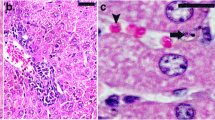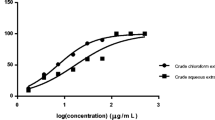Abstract
Reactive Oxygen species play an important role in pathology during malaria infection. The status of hepatic oxidative stress and antioxidant defence indices was studied during Plasmodium yoelii nigeriensis (P. y. nigeriensis) infection in mice and arteether treatment of P. y. nigeriensis infected mice. P. y. nigeriensis infection caused a significant increase in hepatic xanthine oxidase, rate of lipid peroxidation, reduced glutathione (GSH) and glutathione reductase with progressive rise in parasitemia. This was accompanied by a significant decrease in hepatic superoxide dismutase (SOD) and catalase with increase in parasitemia. Arteether treatment (10 mg/kg body weight of mice) of infected mice from day 2 of post infection resulted in complete clearance of parasitemia on day 4 of post infection which was accompanied by restoration of all the oxidative stress and antioxidant defence indices to normal levels.
Similar content being viewed by others
References
World Health Organization, Malaria Unit: Global malaria control. Bull WHO 71: 281–284, 1993
Meshnick SR, Taylor TE, Kamchonwongpaisan S: Artemisinin and the antimalarial endoperoxides: From herbal remedy to targeted chemotherapy. Microbiol Rev 60: 301–315, 1996
Clark IA, Chaudhri G, Cowden WB: Some roles of free radicals in malaria. Free Rad Biol Med 6: 315–321, 1989
Srivastava P, Puri SK, Dutta GP, Pandey VC: Hepatic superoxide scavenging system during Plasmodium berghei infection and chloroquine treatment. Med Sci Res 19: 307–308, 1991
Meister A, Anderson ME: Glutathione. Ann Rev Biochem 52: 711–760, 1983
Lai H, Singh NP: Selective cancer cell cytotoxicity from exposure to dihydroartemisinin and halotransferrin. Cancer Lett 91: 41–46, 1995
Utley HG, Bernheim F, Hochstein P: Effect of sulfhydryl reagent on peroxidation in microsomes. Arch Biochem Biophys 118: 29–32, 1967
Aebi H: Catalase in vitro: In: Meth Enzymol 105. Academic Press, London, 1984, pp 121–126
Beutler E, Duran O, Kelly BM: Improved method of determination of blood glutathione. J Lab Clin Med 61: 882–888, 1963
Racker E: Glutathione reductase. In: Meth in Enzymol II. Academic Press, New York, 1955, pp 722–725
Kakkar P, Das B, Vishwanathan PN: A modified spectrophotometric assay of superoxide dismutase. Ind J Biochem Biophys 21: 130–132, 1984
Nishikimi M, Appaji Raeo N, Yaki K: The occurrence of superoxide anion in the reaction of reduced phenazine methosulphate and molecular oxygen. Biochem Biophys Res Commun 46: 849–854, 1972
Chander R, Lapoor NK, Dhawan BN: Picrolive, picroside I and kutkoside from Picrorhiza kurroa are scavengers of superoxide anions. Biochem Pharmacol 44: 180–183, 1992
Lowry OH, Rosebrough NJ, Farr AL, Randall RJ: Protein measurement with the folin phenol reagent. J Biol Chem 193: 265–275, 1951
Jervis HR, MacCallum DK, Sprinz H: Experimental P. berghei infection in hamster: Its effects on the liver. Arch Pathol 86: 328–337, 1968
Aikawa JE, Suzu M, Gutierez Y: Pathology of malaria. In: JP Krier (ed). Malaria Volume 2. Academic Press, New York, 1980, pp 47–102
Maegraith BG, Skirrow MB, Changsuphajassidhi T: Liver blood flow in Plasmodium knowlesi malaria. Trans R Soc Trop Med Hyg 57: 1, 1963
Pandey VC, Dutta GP, Saxena N, Srivastava R, Ghatak SN: Macaca mullata - a model for studying host parasite relationship in malaria. In: KR Bhardwaj, BN Dhawan (eds). Non-human Primates in Biomedical Research. CDRI, Lucknow, 1986, pp 111–126
White NJ: The pathology of Malaria. In: Advances in Parasitology 31. Academic Press, London, 1992, pp 130–131
Ezio T, Bruno Lotti, Cavallo G, Croce C, Borelli G: Liver xanthine oxidase increase in three pathological models. A possible defence mechanism. Biochem Pharmacol 29: 1939–1943, 1980
Gutteridge JMC, Halliwell B: The measurement and mechanism of lipid peroxidation in biological systems. Trends Biochem 5: 129–135, 1990
Guillemette J, Marion M, Denizeau F, Fournier M, Brosseau P: Characterization of the in vitro hepatocyte model for toxicological evaluation: Repeated growth stimulation and glutathione response. Biochem Cell Biol 71: 7–13, 1993
Kano Y, Fridovich I: Superoxide radical inhibits catalase. J Biol Chem 257: 5751–5754, 1982
Gu HM, Warhurst DC, Peters W: Uptake of [3H] dihydroartemisinin by erythrocytes infected with Plasmodium falciparum in vitro. Trans R Soc Trop Med Hyg 78: 265–270, 1984
Meshnick SR: Free radicals and antioxidants. Lancet 344: 1441–1442, 1994
Author information
Authors and Affiliations
Rights and permissions
About this article
Cite this article
Siddiqi, N.J., Pandey, V. Studies on hepatic oxidative stress and antioxidant defence systems during arteether treatment of Plasmodium yoelii nigeriensis infected mice. Mol Cell Biochem 196, 169–173 (1999). https://doi.org/10.1023/A:1006944313291
Issue Date:
DOI: https://doi.org/10.1023/A:1006944313291




